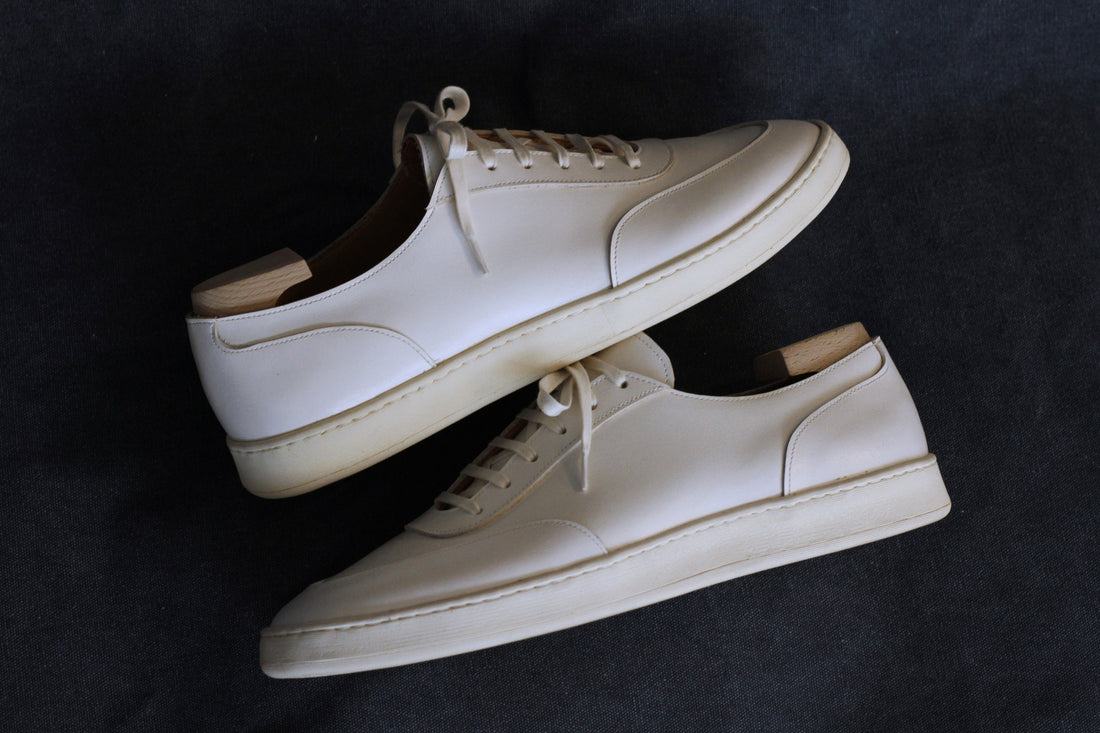
Modern vs Traditional Construction
We have just launched our Travellers Collection and are taking pre-orders for our shoes. Fumu shoes are made in our Singapore workshop using traditional methods and I wanted to share more about how they are made.
Here I will be sharing the difference between a popular modern construction for athletic shoes and sneakers, the Strobel construction, and Fumu's Travellers Collection.
Strobel Construction
Strobel construction involves stitching the upper of the shoe directly onto the insole, usually made of a thin fabric. The insole is cemented to the outsole which results in a flexible and light weight shoe.
 Strobel insole (Green) stitch directly into the upper
Strobel insole (Green) stitch directly into the upper
Benefits
- Light weight & Flexible: the single stitch and cemented construction makes this incredibly flexible and light.
- Cost Effective: This process uses less materials and is less labour-intensive making these shoes affordable.

Upper (L), Foam Sock Liner(M), Cupsole (R)
Drawbacks
- Durability: While flexible and lightweight, the simpler construction might not hold up as well to harsh conditions.
- Support: Because of the choice of lightweight materials and thin insole, these are less rigid and supportive.
Handwelted Construction (Modified)
The handwelted construction is a traditional method where a strip of leather (the welt) is sewn to a thick vegetable insole and upper. The outsole is then stitched onto the welt to create a durable and resoleable shoe.
Our first series from the Travellers Collection is built using a modified hand welted construction. The insoles are carved and channelled by hand, the same way we would make our handwelted shoes. The uppers are then sewn directly into the insole before being attached to a cup sole by a row of side wall stitch.
 Uppers sewn directly into the vegetable tan insole
Uppers sewn directly into the vegetable tan insole
 Gum Hevea Lactae cupsoles with yellow contrast side wall stitch
Gum Hevea Lactae cupsoles with yellow contrast side wall stitch
Benefits
- Durability: Since both the uppers and soles are sewn on, the shoes are highly durability and there is no risk of the soles detaching.
- Support: The thick veg tan insole used offers great stability and will mould to the shape of your feet over time.
- Repairability: Having a durable insole and uppers stitched into it allows the soles to be easily replaced, extending the life of the shoes.

4.5mm Shonan Leather Insoles, bottom has been carved and channelled
Drawbacks
- Cost Effectiveness: This modified hand welted process is done entirely by hand and is a very labour intensive process, raising the cost of the shoes.
- Resoleable: While resoleable, the stitches on the side wall punctures the upper and will eventually give way compared to a fully handwelted shoe.
- Weight: These tend to be heavier and less flexible than Strobel constructed shoes.
 Upper(L), Unfinished Insole (M), Finished Insole (R)
Upper(L), Unfinished Insole (M), Finished Insole (R)
Lasting Methods (Bonus)
As the Strobel construction uses slip lasting or force lasting, there are some limitations to materials that can be employed. Typically the materials must be relatively flexible hence most Strobel shoes use a celastic heel stiffener.
Handwelted shoes are typically lasted by hand, allowing the use of a leather heel stiffener. Compared to a celastic stiffener, leather stiffeners maintain their strength and moulds to the shape of your heel over time. While celastic will soften over time, they do not adapt as well as leather to your feet and tend to become brittle and crack over time.

Leather Stiffener (Top), Celastic Stiffener (Bottom)
Making The Right Choice
When deciding between a Strobel construction and the Travellers Collection, lifestyle and budget is a big consideration. As a shoemaker, I do appreciate brands that able to create shoes at an accessible price point to most. For people who are looking for something more durable, elegant yet versatile enough for everyday wear, do take a moment to explore the Travellers Collection or pre-order yours now here (Ends on 30th April 2025).
